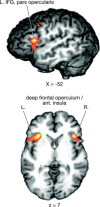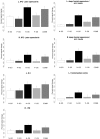The emergence of the unmarked: a new perspective on the language-specific function of Broca's area - PubMed (original) (raw)
The emergence of the unmarked: a new perspective on the language-specific function of Broca's area
Tanja Grewe et al. Hum Brain Mapp. 2005 Nov.
Abstract
A number of neuroimaging studies have implicated an involvement of Broca's area, particularly of the pars opercularis of the left inferior frontal gyrus (IFG), in the processing of complex (permuted) sentences. However, functional interpretations of this region's role range from very general (e.g., in terms of working memory) to highly specific (e.g., as supporting particular types of syntactic operations). A dissociation of these competing accounts is often impossible because in most cases, the language internal complexity of permuted sentence structures is accompanied invariably by increasing costs of a more general cognitive nature (e.g., working memory, task difficulty, and acceptability). We used functional magnetic resonance imaging to explore the precise nature of the pars opercularis activation in the processing of permuted sentences by examining the permutation of pronouns in German. Although clearly involving a permutation operation, sentences with an initial object pronoun behave like simple, subject-initial sentences (e.g., in terms of acceptability) because of a rule stating that pronouns should generally precede non-pro-nominal arguments. The results of the experiment show that in contrast to non-pro-nominal permutations, sentences with a permuted pronoun do not engender enhanced pars opercularis activation. Our findings therefore speak against both language-related working memory and transformation-based accounts of this region's role in sentence comprehension. Rather, we argue that the pars opercularis of the left IFG supports the language-specific linearization of hierarchical linguistic dependencies.
Hum Brain Mapp, 2005. (c) 2005 Wiley-Liss, Inc.
Figures
Figure 1
Mean acceptability ratings and reaction times for each of the critical sentence conditions. Error bars indicate the standard error of the mean.
Figure 2
Averaged activation with a z‐value > 3.1 for the contrast between the non‐pronominal permuted condition (N‐OS) and the control condition (N‐SO).
Figure 3
Average percent signal change (8 to 12 s relative to sentence onset) for regions showing a significant effect of permutation for the non‐pronominal conditions (N‐OS vs. N‐SO). Error bars indicate the standard error of the mean.
Similar articles
- Revisiting the role of Broca's area in sentence processing: syntactic integration versus syntactic working memory.
Fiebach CJ, Schlesewsky M, Lohmann G, von Cramon DY, Friederici AD. Fiebach CJ, et al. Hum Brain Mapp. 2005 Feb;24(2):79-91. doi: 10.1002/hbm.20070. Hum Brain Mapp. 2005. PMID: 15455462 Free PMC article. - Neural aspects of sentence comprehension: syntactic complexity, reversibility, and reanalysis.
Meltzer JA, McArdle JJ, Schafer RJ, Braun AR. Meltzer JA, et al. Cereb Cortex. 2010 Aug;20(8):1853-64. doi: 10.1093/cercor/bhp249. Epub 2009 Nov 17. Cereb Cortex. 2010. PMID: 19920058 Free PMC article. - Linguistic prominence and Broca's area: the influence of animacy as a linearization principle.
Grewe T, Bornkessel I, Zysset S, Wiese R, von Cramon DY, Schlesewsky M. Grewe T, et al. Neuroimage. 2006 Sep;32(3):1395-402. doi: 10.1016/j.neuroimage.2006.04.213. Epub 2006 Jun 12. Neuroimage. 2006. PMID: 16769225 - A neuronal retuning hypothesis of sentence-specificity in Broca's area.
Matchin WG. Matchin WG. Psychon Bull Rev. 2018 Oct;25(5):1682-1694. doi: 10.3758/s13423-017-1377-6. Psychon Bull Rev. 2018. PMID: 28940045 Free PMC article. Review. - The role of Broca's area in sentence comprehension.
Rogalsky C, Hickok G. Rogalsky C, et al. J Cogn Neurosci. 2011 Jul;23(7):1664-80. doi: 10.1162/jocn.2010.21530. Epub 2010 Jul 9. J Cogn Neurosci. 2011. PMID: 20617890 Review.
Cited by
- Investigation of the Processing of Noun and Verb Words with fMRI in Patients with Schizophrenia.
Nazli ŞB, Koçak OM, Kirkici B, Sevındık M, Kokurcan A. Nazli ŞB, et al. Noro Psikiyatr Ars. 2019 Nov 28;57(1):9-14. doi: 10.29399/npa.23521. eCollection 2020 Mar. Noro Psikiyatr Ars. 2019. PMID: 32110143 Free PMC article. - Syntactic processing in the human brain: what we know, what we don't know, and a suggestion for how to proceed.
Fedorenko E, Nieto-Castañón A, Kanwisher N. Fedorenko E, et al. Brain Lang. 2012 Feb;120(2):187-207. doi: 10.1016/j.bandl.2011.01.001. Epub 2011 Feb 18. Brain Lang. 2012. PMID: 21334056 Free PMC article. Review. - Task-dependent and task-independent neurovascular responses to syntactic processing.
Caplan D, Chen E, Waters G. Caplan D, et al. Cortex. 2008 Mar;44(3):257-75. doi: 10.1016/j.cortex.2006.06.005. Epub 2007 Nov 19. Cortex. 2008. PMID: 18387556 Free PMC article. - Neural correlates of pronoun processing: An activation likelihood estimation meta-analysis.
El Ouardi L, Yeou M, Faroqi-Shah Y. El Ouardi L, et al. Brain Lang. 2023 Nov;246:105347. doi: 10.1016/j.bandl.2023.105347. Epub 2023 Oct 15. Brain Lang. 2023. PMID: 37847932 Free PMC article. - Longitudinal changes in resting-state fMRI from age 5 to age 6years covary with language development.
Xiao Y, Friederici AD, Margulies DS, Brauer J. Xiao Y, et al. Neuroimage. 2016 Mar;128:116-124. doi: 10.1016/j.neuroimage.2015.12.008. Epub 2015 Dec 12. Neuroimage. 2016. PMID: 26690809 Free PMC article.
References
- Aguirre GK, Zarrahn E, d'Esposito M (1997): Empirical analyses of BOLD fMRI statistics II. Spatially smoothed data collected under null‐hypothesis and experimental conditions. Neuroimage 5: 199–212. - PubMed
- Bader M, Meng M (1999): Subject‐object ambiguities in German embedded clauses: an across‐the‐board comparison. J Psycholinguist Res 28: 121–143.
- Baker M (1988): Incorporation: a theory of grammatical function changing. Chicago: University of Chicago Press.
- Ben‐Shachar M, Hendler T, Kahn I, Ben‐Bashat D, Grodzinsky Y (2003): The neural reality of syntactic transformations: evidence from fMRI. Psychol Sci 14: 433–440. - PubMed
- Ben‐Shachar M, Palti D, Grodzinsky Y (2004): Neural correlates of syntactic movement: converging evidence from two fMRI experiments. Neuroimage 21: 1320–1336. - PubMed
Publication types
MeSH terms
LinkOut - more resources
Full Text Sources
Miscellaneous


